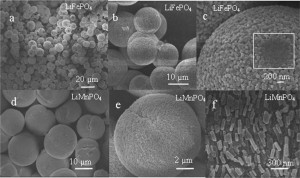Lithium ion batteries are widely used as portable sources of electric energy, from powering gadgets to cars. As such, there has been great interest in improving their performance, and one of the most promising routes is to use LiMPO4 (where M is either Mn or Fe) hierarchical structures in the battery electrodes. Nevertheless, a synthetic method that is both low cost and do not require harsh chemicals is still necessary for these structures to be used more widely in lithium ion batteries.
In this paper, the authors presented a method of synthesising LiMPO4microspheres via a solvothermal process in a solution of glycerol, citric acid and water. These microspheres had a 3D hierarchical structure, in which the larger spheres are either composed of nanoparticles(LiFePO4) or nanorods (LiMnPO4). They investigated the effects of changing the concentrations of the starting materials have on the morphology of the overall structure, and the growth mechanisms of the crystals. They also used the LiMPO4 microstructures as the cathode in a lithium ion battery set-up to measure their electrochemical properties.
The authors found that the microspheres had high reversible specific capacity and cycling performance, making them ideal candidates for use in batteries. This work opens up a cheap and safe route to manufacturing high performing lithium-ion batteries.
Read their article now to find out more:
Synthesis of 3D-hiearchical LiMPO4 (M = Fe, Mn) microstructures as cathode materials for lithium-ion batteries
Yuanxiang Gu, Weiming Liu, Lei Wang, Guicun Li and Yu Yang
CrystEngComm, 2013, Advance Article
DOI: 10.1039/C3CE00072A, Paper











